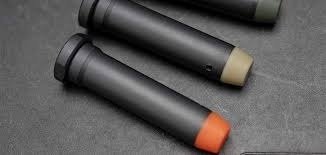Ever wonder why some rifles feel smoother to shoot than others, even when they’re nearly identical? The answer often lies in the buffer system. This essential internal component plays a major role in managing recoil and overall firearm behavior. Whether you’re customizing your rifle or fine-tuning it for better results, understanding how buffer types influence control can make all the difference; let’s explore what goes into a buffer system and how small adjustments can lead to big improvements.
Why the Buffer System Matters More Than You Think
One of the most overlooked AR-15 parts in a standard setup is the buffer system, yet it directly affects how your rifle handles each shot. The buffer helps absorb rearward motion when a round is fired. Along with the spring, it slows the bolt's movement, resets the system, and preps it for the next round. A mismatched buffer can create issues such as excessive recoil, failure to cycle, or increased wear on parts. By understanding the impact of this component, shooters can fine-tune their firearm's operation for improved comfort and reliability.
Carbine vs. Rifle Buffers: What’s the Difference?
The type of buffer system used often depends on your rifle's configuration, mainly the length of the receiver extension or tube. Carbine buffers are shorter and commonly used in compact builds. Rifle buffers, on the other hand, are longer and work with full-length stocks. Each has its own spring type and weight category. Switching between them requires attention to compatibility, especially when modifying for precision or rapid-fire setups. Choosing the wrong one can cause short-stroking, extra kick, or even part damage.
Buffer Weight and Its Role in Performance
One of the easiest ways to adjust recoil and reliability is by changing buffer weight. Light, standard, heavy (H1, H2, H3), and even specialized versions offer options. Heavier buffers reduce felt recoil and slow down the cycling rate, which can be beneficial for shooters who prefer softer recoil and suppressed setups. Lighter options allow faster cycling but may increase recoil and stress. Finding the balance between cycling speed and comfort depends on your ammo, barrel length, and gas system. This is where attention to detail pays off.
Spring Tension Can Fine-Tune Feel
While the buffer gets much of the attention, the spring inside the tube is just as important in determining how your rifle feels and functions. A stiffer spring slows down the bolt’s movement, making the recoil impulse more controlled. Softer springs result in quicker action but may lead to premature wear or failures in feeding. High-performance springs can work well in competition builds or suppressed platforms. They offer longevity and reduce mechanical noise while enhancing overall shooting smoothness.
Tuning for Purpose: What Works Best for You
The ideal buffer system setup depends on how you use your rifle. Tactical builds, long-range configurations, and competition rifles all benefit from different combinations. For example, suppressed rifles often need heavier buffers to compensate for increased back pressure.
Lightweight race guns may perform better with reduced-weight parts for faster follow-up shots. There’s no one-size-fits-all solution. The key is to match your buffer components to your rifle’s role and operating conditions. A well-tuned system improves function and enhances your experience behind the trigger.
Your rifle’s buffer system is more than just a background part. It’s a central player in how your firearm functions and feels. Understanding the balance between buffer weight, spring tension, and system length allows you to make smart upgrades. While there are many AR-15 parts worth attention, this one has an outsized impact on comfort and control. Take the time to tune it right, and you’ll notice a difference every time you pull the trigger.
 Online Clock
Online Clock